Your kitchen contains the biggest energy and water hogs in your home. With all the resources in use in this popular room, there are many ways for energy to be used inefficiently. Luckily, changing a few cooking habits and using your appliances more efficiently can help you reduce your kitchen energy usage and save some cash.
Consider these kitchen energy-saving tips to use your appliances more efficiently and reduce the cost of your bills.
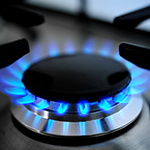
Keep Oven and Stove Heat Where It Belongs
When using the oven, preheat for 5-8 minutes only, and cut cooking time up to 20% by moving the rack closer to the heating unit. Every time you open the oven door, you lose 25-30 degrees, so check the food with the oven light instead. Save energy and time by using the self-cleaning feature right after cooking to take advantage of residual heat.
For smaller meals, cut usage in half with an electric pan or toaster oven. Slow cookers are a great alternative and average a dime’s worth of electricity per meal. Cut out electricity altogether by grilling outside, and you’ll avoid forcing the refrigerator to work harder in a hot kitchen.
If you have a gas range, confirm you are getting a blue flame. A yellow flame means the fuel is burning inefficiently, and your gas line should be checked by your gas company. When buying new, look for an oven with an automatic electric ignition system instead of having a continuously burning pilot light.
On top, purchase reflective (instead of dull) burner pans to direct more heat to cookware and save one-third of the energy usage. Blackened, dirty burner pans absorb heat and reduce efficiency, so clean them regularly. Reduce heat loss by using pots and pans with flat bottoms and matching them to the correct burner size.
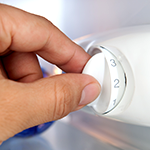
Avoid Overworking Your Refrigerator and Freezer
Another energy-saving tip is to not set your refrigerator and freezer colder than necessary. The Department of Energy recommends setting refrigerators between 36-40°F and freezers between -5-0°F.
You can do simple things to prevent your refrigerator from working overtime. Maintain circulation by not overcrowding the shelves. Make the condenser work more efficiently by waiting for food to cool before storing and covering containers to prevent moisture. Every three months, vacuum the condenser coils underneath and behind the unit. Test for air leakage by closing the door over a piece of paper. If you can pull the paper out easily, look into getting a new latch or seal.
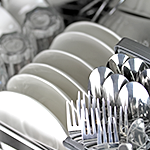
Reduce Water Usage
Conventional faucets flow up to five gallons per minute, but you can reduce this to 1.5 gallons simply by installing a low-flow faucet. Remember to choose cold water for rinsing, filling pots or running the garbage disposal. In fact, skip the garbage disposal and create a compost heap instead.
Dishwashers save time, but they raise utility bills, too. Wait until you have a full load and let dishes air dry after cleaning. The “rinse hold” setting uses 3-7 gallons of hot water per use, so ignore this setting when you only have a few soiled dishes. When purchasing a dishwasher, look for options with internal booster heaters, so that you can set your water heater thermostat at 120°F (rather than 140°F for dishwashing purposes).
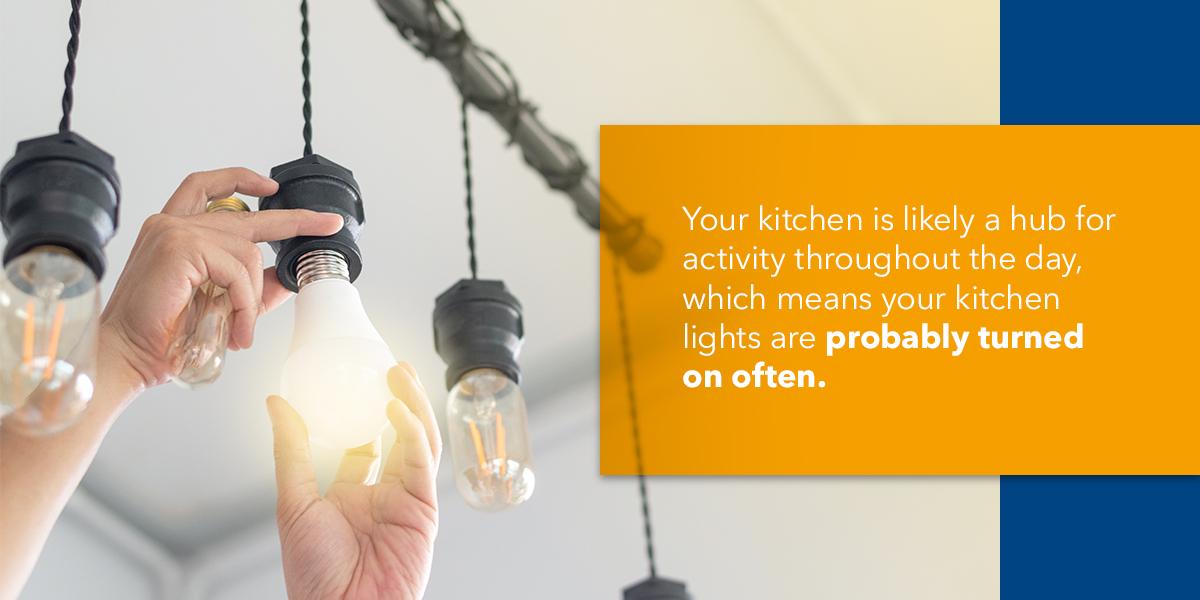
Use Energy Efficient Light Bulbs
Your kitchen is likely a hub for activity throughout the day, which means your kitchen lights are probably turned on often. Traditional light bulbs can burn a lot of unnecessary energy, especially if you have these lights turned on more than others. Consider replacing your light bulbs with a more energy-efficient option. For example, LED bulbs last longer and use about 90% less energy than traditional light bulbs.
Setting your kitchen lights on timers or dimmers can also help reduce energy use. Timers automatically turn your lights off after a specified amount of time, which can be especially helpful for families who leave lights on due to forgetfulness. Dimmers allow you to lower the light levels so you’re using less electricity than powering them at full capacity.
Install Window Film
While all these energy tips can help you cut back on energy use, one of the longest-lasting changes you can make is installing window films.
Your windows can significantly impact your energy consumption, especially when it comes to heating and cooling your house. In the winter, heat can escape through your windows, and the same can happen to the cool air from your air conditioning in the summer. Install window films to help keep your house warm in the winter and cool in the summer. With window films, your heating and air conditioning systems can run more efficiently, thus saving energy and money.
Find a Madico Window Film Dealer
Without making major changes, you can make your kitchen more energy efficient and save considerably on your monthly costs. Window films from Madico®, Inc. can help increase your home energy savings year-round while also providing a number of additional benefits, like:
- Glare control: Windows let in a lot of sunlight, which can create glare on your television and other devices. Reduce the annoying glare that makes it difficult to see your screens with Madico solar control film.
- Aesthetics: Madico window films are as functional as they are aesthetically pleasing. We create our films in a variety of hues and shades so you can find a film that adds to the look of your house.
- Fade prevention: As the sun shines through your windows, the UV rays can damage your furniture, flooring and other upholstery. After a while, they’ll fade and look worn. Madico window films help to block out harmful UV rays and preserve your belongings.
- Skin protection: Our window films can also help protect your skin. Sunlight can still damage your skin through windows, so window film provides an extra layer of UV protection.
Find a Madico window film dealer to start reducing your energy consumption today!


 You may want to start with the window film and then choose your installer, because different installers carry different types of window film. Window film that blocks damaging UV rays is a popular choice and it can actually
You may want to start with the window film and then choose your installer, because different installers carry different types of window film. Window film that blocks damaging UV rays is a popular choice and it can actually  Like choosing any business, one of the best ways to make your decision is by asking others who they recommend. You can also view online referrals and rankings on various sites. Once you’ve identified some credible options, ask the installer how long he or she has been in business at their current location. The longer the better as longevity is a sign that they offer good quality and service at fair prices. You’ll also want to see samples of their work. This article has
Like choosing any business, one of the best ways to make your decision is by asking others who they recommend. You can also view online referrals and rankings on various sites. Once you’ve identified some credible options, ask the installer how long he or she has been in business at their current location. The longer the better as longevity is a sign that they offer good quality and service at fair prices. You’ll also want to see samples of their work. This article has  You may be tempted to save some money and try a do-it-yourself kit, but there are several reasons why it’s smart to go with a professional window tinting company.
You may be tempted to save some money and try a do-it-yourself kit, but there are several reasons why it’s smart to go with a professional window tinting company. 
 If a certain room in your home feels hotter or colder than other areas, you may have hidden air leaks. Find them with a thermal leak detector, which is a device that uses an infrared laser to measure surfaces for dips and peaks from a reference temperature. To locate where you are losing energy specifically, shine the device around doors, windows, and footings. Most devices alert you to differences in temperature by changing from neutral green to red (hot) or blue (cold) so that you can pinpoint outside air drafts, and determine where you need to seal air leaks.
If a certain room in your home feels hotter or colder than other areas, you may have hidden air leaks. Find them with a thermal leak detector, which is a device that uses an infrared laser to measure surfaces for dips and peaks from a reference temperature. To locate where you are losing energy specifically, shine the device around doors, windows, and footings. Most devices alert you to differences in temperature by changing from neutral green to red (hot) or blue (cold) so that you can pinpoint outside air drafts, and determine where you need to seal air leaks. Electrical outlets and wall switches located on exterior walls can be responsible for up to 5% of energy loss in your home. Installing foam outlet gaskets are an easy and inexpensive way to reduce incoming drafts and outgoing temperature-controlled air. Your local hardware store will offer plates and switch covers with the foam attached or you can grab a box of gaskets and install them behind your current covers. Some plates are even spring-loaded to cover plug holes when not in use, which blocks even more air loss, and provides added protection for children.
Electrical outlets and wall switches located on exterior walls can be responsible for up to 5% of energy loss in your home. Installing foam outlet gaskets are an easy and inexpensive way to reduce incoming drafts and outgoing temperature-controlled air. Your local hardware store will offer plates and switch covers with the foam attached or you can grab a box of gaskets and install them behind your current covers. Some plates are even spring-loaded to cover plug holes when not in use, which blocks even more air loss, and provides added protection for children.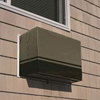 If your air conditioner is mounted permanently in a window or built into the wall, then winter winds can sift through your unit into the home and cause drafts, heat loss, and a higher electric bill. A quilted or insulated air conditioner cover will shield your unit from taking in cold air and can protect it from leaves, dust, and snow, which helps it function better when it’s time to use it in summer. You can choose a cover to place over your conditioner from the inside or the outside. You’ll find cover options in different sizes and materials (indoor ones are typically machine-washable). Some covers attach with Velcro, while others use elastic to wrap the unit like a fitted sheet. Besides a cover, add some weatherstripping to seal between the unit and window frame, and you’ve taken a big step in keeping yourself warmer in winter.
If your air conditioner is mounted permanently in a window or built into the wall, then winter winds can sift through your unit into the home and cause drafts, heat loss, and a higher electric bill. A quilted or insulated air conditioner cover will shield your unit from taking in cold air and can protect it from leaves, dust, and snow, which helps it function better when it’s time to use it in summer. You can choose a cover to place over your conditioner from the inside or the outside. You’ll find cover options in different sizes and materials (indoor ones are typically machine-washable). Some covers attach with Velcro, while others use elastic to wrap the unit like a fitted sheet. Besides a cover, add some weatherstripping to seal between the unit and window frame, and you’ve taken a big step in keeping yourself warmer in winter. A zero net energy building must produce as much or more energy than it needs to maintain. This entails a renewable energy system and various energy efficiency measures that will offset the home’s annual energy consumption.
A zero net energy building must produce as much or more energy than it needs to maintain. This entails a renewable energy system and various energy efficiency measures that will offset the home’s annual energy consumption. Taking small steps and implementing a few energy-saving tactics at a time is perhaps a smart way to go about it, especially if you’re working with an older home.
Taking small steps and implementing a few energy-saving tactics at a time is perhaps a smart way to go about it, especially if you’re working with an older home.  The Fishers started with insulating the attic and then quickly moved on to their windows. Living in a hurricane-risk state, these Floridians opted for Energy Star certified double-paned windows. Of course, they didn’t stop there. To make their windows more efficient, they
The Fishers started with insulating the attic and then quickly moved on to their windows. Living in a hurricane-risk state, these Floridians opted for Energy Star certified double-paned windows. Of course, they didn’t stop there. To make their windows more efficient, they  Safety, care, and protection are all major objectives that hospitals try to achieve with every patient. To further this commitment, Baylor St. Luke’s Medical Center installed Madico’s safety & security window films earlier this year. With its location relative to the Gulf Coast, it was prone to harsh weather conditions resulting in severe damages. The 850-bed health and surgical facility, made up of an extensive number of windows, needed an additional layer of security to account for serious weather damages. Window film was the plausible solution for this issue, and now there is a sense of “greater safety and peace of mind” among the patients and the St. Luke’s team.
Safety, care, and protection are all major objectives that hospitals try to achieve with every patient. To further this commitment, Baylor St. Luke’s Medical Center installed Madico’s safety & security window films earlier this year. With its location relative to the Gulf Coast, it was prone to harsh weather conditions resulting in severe damages. The 850-bed health and surgical facility, made up of an extensive number of windows, needed an additional layer of security to account for serious weather damages. Window film was the plausible solution for this issue, and now there is a sense of “greater safety and peace of mind” among the patients and the St. Luke’s team. In the case of a natural disaster, medical facilities need to have a plan for their patients’ safety.
In the case of a natural disaster, medical facilities need to have a plan for their patients’ safety.  Additionally, window film rejects 99% of harmful UV rays that cause skin cancer, providing another form of protection for hospital patients. It can also block up to 86% of the sun’s heat, making a medical facility more comfortable for those being treated. The significant reduction of the sun’s heat aids in the building’s energy efficiency as less energy is needed from the HVAC cooling systems and can save up to 30% of a building’s cooling costs.
Additionally, window film rejects 99% of harmful UV rays that cause skin cancer, providing another form of protection for hospital patients. It can also block up to 86% of the sun’s heat, making a medical facility more comfortable for those being treated. The significant reduction of the sun’s heat aids in the building’s energy efficiency as less energy is needed from the HVAC cooling systems and can save up to 30% of a building’s cooling costs.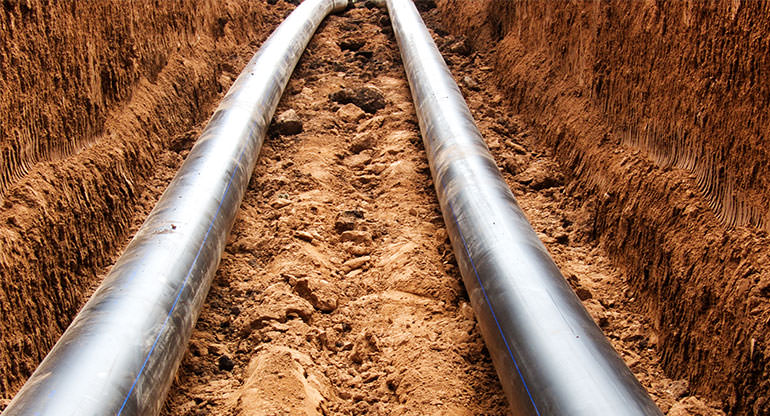
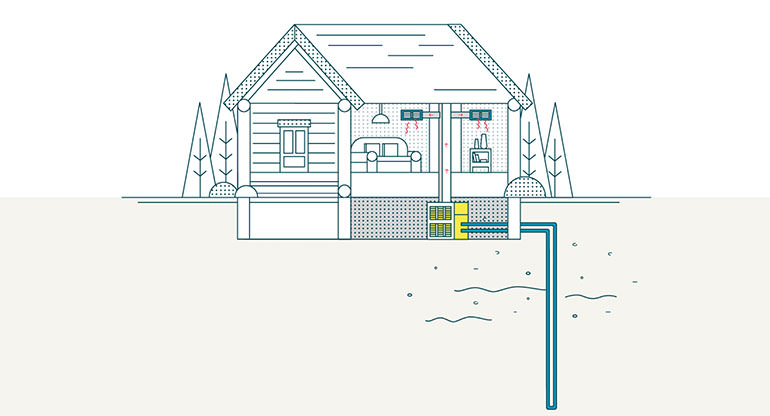
 Many apartment complexes have large windows and sliding glass doors which allow in direct sunlight. When the sun shines in, it heats up living spaces and runs up utility bills—both for the owner and the tenants. Having quality window film professionally installed can reduce unwanted solar heat gain by more than 80%, and cut cooling costs by as much as 30%, according to the International Window Film Association (IWFA).
Many apartment complexes have large windows and sliding glass doors which allow in direct sunlight. When the sun shines in, it heats up living spaces and runs up utility bills—both for the owner and the tenants. Having quality window film professionally installed can reduce unwanted solar heat gain by more than 80%, and cut cooling costs by as much as 30%, according to the International Window Film Association (IWFA). Window film installation can be three times more cost effective than replacing an air conditioner. In fact, window film can extend the life of HVAC systems by reducing maintenance and strains on the system.
Window film installation can be three times more cost effective than replacing an air conditioner. In fact, window film can extend the life of HVAC systems by reducing maintenance and strains on the system. There are also a wide range of
There are also a wide range of  Japan came in second in the national efforts category based on the ACEEE
Japan came in second in the national efforts category based on the ACEEE  Both countries tied with 16 points in the area of conserving energy through transportation. Italy participates in the EU’s
Both countries tied with 16 points in the area of conserving energy through transportation. Italy participates in the EU’s  Italy has set standards in the industrial sector by establishing energy conservation targets. The country now requires all plant managers to meet these targets while implementing periodic audits. According to Italy’s
Italy has set standards in the industrial sector by establishing energy conservation targets. The country now requires all plant managers to meet these targets while implementing periodic audits. According to Italy’s 
 into preserving energy, we can make estimations based on past successes. For example, based on an
into preserving energy, we can make estimations based on past successes. For example, based on an  Well, according to this
Well, according to this